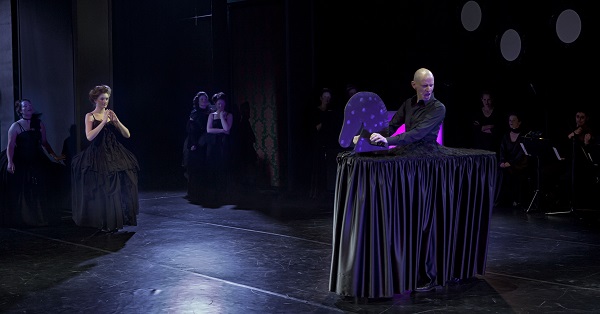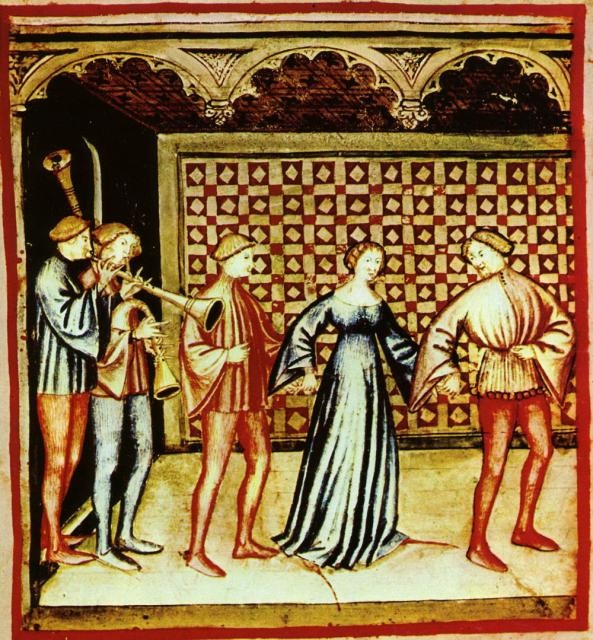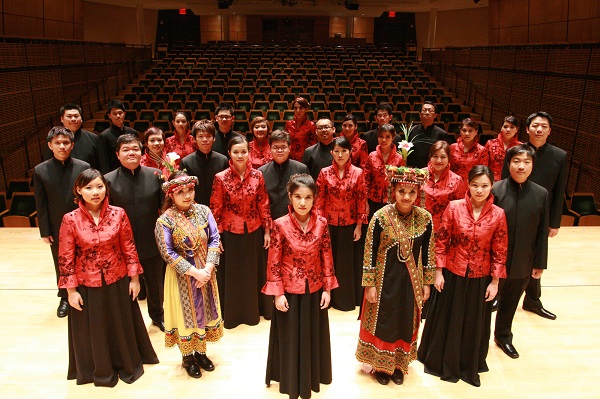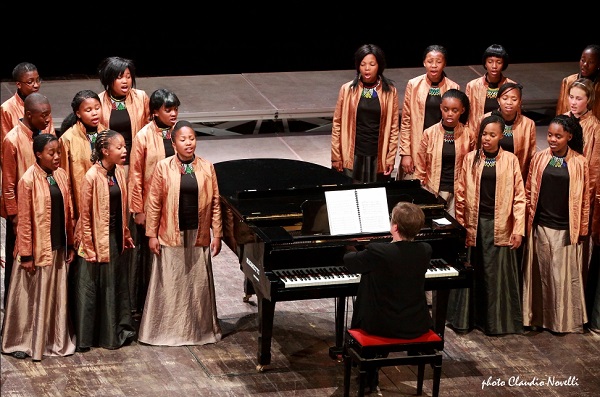The New Eve and the Tactics of Guerrilla Celibacy (Page 53)
‘Placebo’ premiered at the Choregie Festival in Maribor
Graham Lack
composer and ICB Consultant Editor
It is an infantile superstition of the human spirit that virginity should be thought a virtue and not the barrier that separates ignorance from knowledge.[1]
François-Marie Arouet Voltaire
The profound effect that religious belief has on mankind is hard to dispute. Exactly how religions come into being and the specific nature of their most powerful mechanisms are more difficult to quantify. Where belief systems impinge on art, it is useful perhaps to examine how individuals are impacted and to what extent any change of heart or mind has taken place. In an issue entitled ‘Belief Special’, the New Scientist recently queried very similar statements in order to ascertain just why we believe what we believe. As Robin Dunbar pointed out:
“Religious belief is a conundrum. In our everyday lives, most of us make at least some effort to check the truth of claims for ourselves. Yet when it comes to religion, studies show that we are most persuaded by stories that contradict the known laws of physics. Tales of supernatural beings walking on water, raising the dead, passing through walls, foretelling the future, and the like, are universally popular. At the same time, however, we expect our gods to have normal human feelings and emotions. We like our miracles, and those who perform them, to have just the right mix of otherworldliness and everyday characteristics. Why are we humans so willing to commit to religious beliefs we can never hope to verify?”[2]
Well, not on this earth and not in this life, many would argue where verification is concerned. Be all of this as it may, any examination of how art – in the present case contemporary music theatre – can effectively explore religion will perforce rely on the examination of a physical space, one in which belief is enacted and where artistic thought mirrors such at times obdurate convictions. The virtual space was the International Festival of New Music Theatre, ‘Choregie’, held from 8 to 13 January 2012 within the actual confines of the Union Hall in Maribor, Slovenia, as well as at other venues, in the Cathedral of Ljubljana for example. This was the third year that an obviously innovative series of events has taken place.
The reason for hanging this particular article conveniently on the journalistic peg of religion is a new work of music theatre by the founder of ‘Choregie’, Karmina Šilec, called Placebo – Is There One Who Would Not Weep.
The piece was the final offering of five elaborately staged events (the others being Oriana, La licorne de la vierge, Women’s delights and Who’d have thought that snow falls) and must be seen against the backdrop of a devoutly Catholic country like Slovenia. Presented as a ‘stage concert in 14 tableaux’, Placebo, like the other pieces, explores ostensibly the theme of virginity as related in the Bible and other annals of Christianity. A number of what the festival programme calls ‘virgin superstars’ act as an exegetic gloss on a subject that, far from being taboo, constantly reoccurs throughout the history of the Christian faith. The figures range from Sponsa Christi, the Virgin Mary, the Daughters of Jerusalem, Queen Elizabeth I, the Unicorn Virgin and, somewhat bafflingly at first glance, but by extrapolation one assumes, Rand Abdel-Qader.[3]
Karmina Šilec explains that there are: “…virgin lamas, hamsters, moles, rats, elephants, chimpanzees, lemurs, whales, and so on”, and adds that any such appreciation of virginity makes a “lot of sense”, because Jesus was “interested in eunuchs of all kinds [and] soon after his death, for the next 500 years, the idea of a Christian approach to the subject was developed”, concluding that this development, of monotheism in this case, included “various misogynist and erotophobic treatments – using guerrilla celibacy tactics” to transform virginity into “the highest moral value”.[4] So much is clear.
Šilec’s musings may, in turn, be seen within a certain literary milieu, one in which:
“A turn in feminist theory … began to lay the blame for childhood neuroses squarely on the mother. Their feminist world was neatly divided against itself: plenty of feminists still wished to state their objection to patriarchal society, but other feminists took a step back from the campaign for equality. Postmodern readings of Nietzsche have highlighted the similarity between Nietzsche’s thoughts on femininity and those of biological feminists like Luce Irigaray … By the end of the twentieth century, a biological feminism of the type abhorred by Simone de Beauvoir reasserted itself: it became modish to believe that woman had a different nature to man, spoke with a different language and inhabited a different sphere. Irigaray has been at the forefront of attempts to put theory into practice by ‘writing her body’, not always very intelligibly.”[5]
The implications for a piece like Placebo are inherent. In the first part, which can largely be described as Marian, femininity is subsumed under the mantle of maternity and the ordering of this maternal libido is carried farthest into a connexion with the theme of death. The Christian concept of the virgin mother is transformed into a metaphor for women’s ‘becoming’. As the most significant religious image of the Western world, the Virgin Mary is lent, albeit unofficially, the status of a Catholic goddess but, as Mother Mary, proves to be a social construct and thus part of historical reality in that she is an instrument of supervision and control. In the second part, several fundamental features converge in the figure Mary, who emerges as the New Eve. She is an object of imaginary love, and a substitute for suppressed male libido.

The vehicle that transports the ideas discussed so far is, naturally enough, music. And Placebo draws extensively on the Stabat Mater by Giovanni Battista Pergolesi (1710–1736) with its iconic and moving texts ‘Stabat Mater Speciosa’ and ‘Stabat Mater Dolorosa’ by Jacopone da Todi (1230/1236–1306). The work was not penned by the composer, but, as the contemporary Italian novelist Nicola Lecca claims, by “God who merely used Pergolesi”.[6]
The passage of time has not, it would seem, affected the sexual ambiguity in Pergolesi’s piece. But reception history is a fickle thing, and some feminist writers such as Julia Kristeva[7] have encountered problems when linking the music to new feminine ethics. We are dealing with a paradox, where the Virgin gives birth to God but “owes fealty to him”, reigns as “Queen of Heaven but kneels before her son”, and enjoys the privilege of being without sin but “renounces her body to remain so”.[8]
As Richard Will points out in an incisive essay on the composer where, among many other prevalent notions, he examines Kristeva’s views:
“The young Pergolesi … was dying of tuberculosis when he wrote his immortal Stabat Mater … Man overcomes the unthinkable of death by postulating maternal love in its place. Like eighteenth-century resentment of Pergolesi’s ‘femininity’, this celebration of maternal warmth in the Stabat Mater may suggest that its political import is feminist.”[9]
There is unfortunately not space here to discuss the descriptive and supplicatory passages in the work, suffice it say that the key scheme would seem to be deliberate. The doctrine of the affections is perfectly harnessed as E flat major gives way to D Major, and F Major to F minor. Five of the six movements, moreover, begin and end in the same key. At a local level, there is little respite in terms of dissonance. A mother is marked by pain. But to continue with some of the categories suggested by Kristeva:
“Despite her valorization of motherhood, identifying it with the embodied expression of unconditional love opens the way to the same kind of coercion that Liguori practised on the Virgin Mary. How much agency can a mother have when, lacking the critical faculty of language, she can respond to pleas for immortality only with a physical embrace?”[10]
The score of Stabat Mater was sympathetically vocalised by the girls’ choir Carmina Slovenica and the Slovenian Chamber Choir, and expertly rendered by Marko Hatlak (accordion) and Karmen Pečar (violoncello), along with the four members of Musica Cubicularis on a viola da gamba and baroque violins. This music was interspersed with other items, including Antonio Vivaldi’s own setting of the Stabat Mater, a Stabat Mater Dolorosa by one Jacob Cooper, the ‘Gramatam čellam’ from the String Quartet No. 4 by Peteris Vasks, Adnan Songbook by Gavin Bryars, Chocolate Jesus by Tom Waits (arr. Martin Ptak), and a Maronite hymn, Wa Habibi (arr. Karmina Šilec). Any dramaturgical significance was subsumed in the flow of the music, in indeed, the “flow of the project”, based as it is on the idea of “slow listening”.[11]
Curious if benign Sapphic moments intermingled with naughty ones – Tom Waits was never one to mince his words, and high camp seemed out of place here – but often it was the at times deliberately spastic choreography allotted to Carmina Slovenica which provided welcome visual distraction. If this managed to avoid any immediate clichés traceable to, say, Maurice Béjart or Merce Cunningham, then it certainly managed to pay at least gentle homage to the Ballet Rambert[12] of the 1970s and its much-loved sur la demi-pointe style.
The Union Hall in Maribor is a difficult space to light. And the person entrusted with this task, Andrej Hajdinjak, might well have preferred a church venue, forced as he was into a situation in which the audience was lit seemingly as much as the singers. But ‘Choregie’ is only in its third year, and such comments are in a way niggardly. A certain thread does run through the tissue of events: Virginity, as deliberated in the documentation to the festival itself. And the tactics of guerrilla celibacy do much to sponge off the stain of biological feminism. It is a process of canalisation, a process in which a solid cord turns into a canal. And when the last step is taken (we are talking of course about the formation of the female body in the womb), the vagina is at last given an outlet. This is what:
“… creates the hymen … the same stuff that forms the inner layer of the rest of the vagina. It is a thin, flexible, smooth, hairless, mucous membrane. Just like the inside of the mouth or nose or the side of the eyelid that touches the eyeball, it is moist and very soft. Unlike the rest of [the] vagina, however, the hymen has no muscular tissue underneath that thin smooth upper layer … It possesses few nerves or none at all. Hymens offer a wide and colourful variety of configuration and shape. A hymen might be fragile and barely there, or resilient and rubbery, it might be so scanty as to be overlooked, or appear in plentiful, tender, flowerlike folds that double over on themselves. The hymen is part and parcel of the vagina … Like the top of the instep of the foot … Virginity reflects no known biological imperative and grants no demonstrable evolutionary advantage, nor has being able to recognise it in others been shown to increase anyone’s chances of reproduction or survival.”[13]
Such literary flight remains imperforate. It leads us to believe that:
“… contesting the hymen as a site of surety can stand as a paradigm for the problematic epistemology of the female body”.[14]
So, if the New Eve is really to emerge within a discourse of hymenology, this must be reflected in both the theatrical and the anatomical. This would seem to be stretching a point.
[1] The original runs: “C’est une des superstitions de l’esprit humain d’avoir imaginé que la virginité pouvait être une vertu.” Notebooks (ca. 1735–ca. 1750), taken from the Leningrad Notebook, or ‘Le Sottisier’, published posthumously.
[2] Robin Dunbar, ‘How Evolution found God’, in New Scientist, Issue 2536, 28th January 2006, p. 30.
[3] An Iraqi teenage girl brutally murdered by her father on 16th March 2008 in an ‘honour killing’ after she had fallen in love with a British soldier in Basra.
[4] Karmina Šilec, ‘The Importance of Being a Virgin’, in Programme Book to ‘Choregie’ Festival 2012, translated from the Slovenian by Saša Požek, pages unnumbered.
[5] Carol Diethe, ‘Nietzsche Emasculated: Postmodern Readings’, in Ecce opus: Nietzsche-Revisionen im 20. Jahrhundert, ed. Rüdiger Görner & Duncan Large, Vandenhoeck & Ruprecht, Band 81 der Reihe ‘Publications of the Institute of Germanic Studies’ (University of London School of Advanced Study), Göttingen, 2003, p. 53.
[6] Quoted above the anonymous essay ‘About Music’ in Programme to Placebo, ‘Choregie’ Festival 2012, pages unnumbered. The passage is spoken by one of the characters in his Hotel Borg. The author is grateful to the writer for this information.
[7] Two extensive quotes, presumably from her essay ‘Stabat Mater’ are included in the Programme to Placebo, ‘Choregie’ Festival 2012, but see fn. 8, below.
[8] Julia Kristeva, ‘Stabat Mater’, in Tales of Love, trans. Leon S. Roudiez, New York: Columbia University Press, 1987, p. 257.
[9] Richard Will, ‘Pergolesi’s Stabat Mater and the Politics of Feminine Virtue’, Musical Quarterly, Vol. 87 (Fall), Issue 3 (2004), p. 608.
[10] Ibid., p. 608.
[11] Anon., ‘About Music’, in Programme to Placebo, ‘Choregie’ Festival 2012, pages unnumbered.
[12] Now the Rambert Dance Company.
[13] Karmina Šilec, ‘Hymenology’, in Programme Book to ‘Choregie’ Festival 2012, translated from the Slovenian by Saša Požek, pages unnumbered.
[14] Marie H. Loughlin, Hymeneutics: Interpreting Virginity on the Early Modern Stage, Bucknell University Press, Lewisburg, PA, 1997, p. 31.









